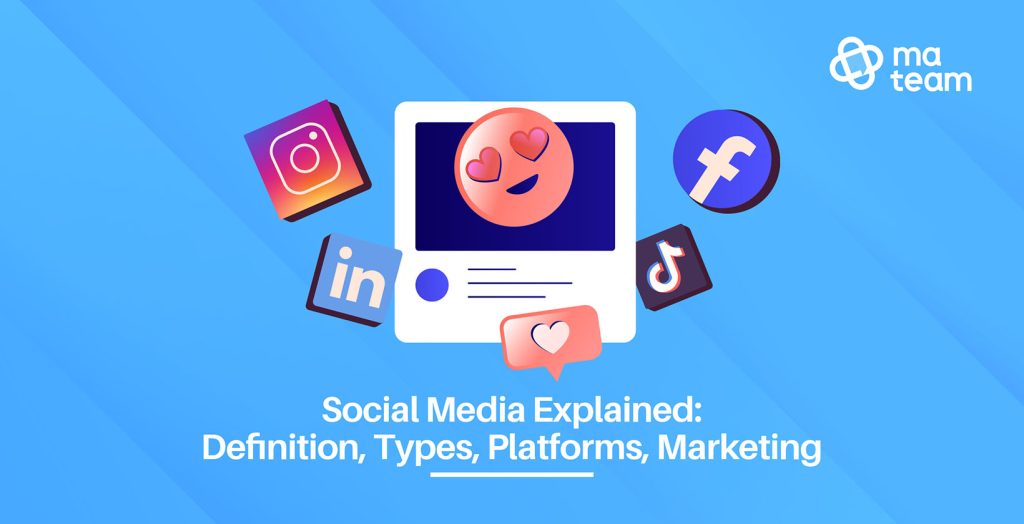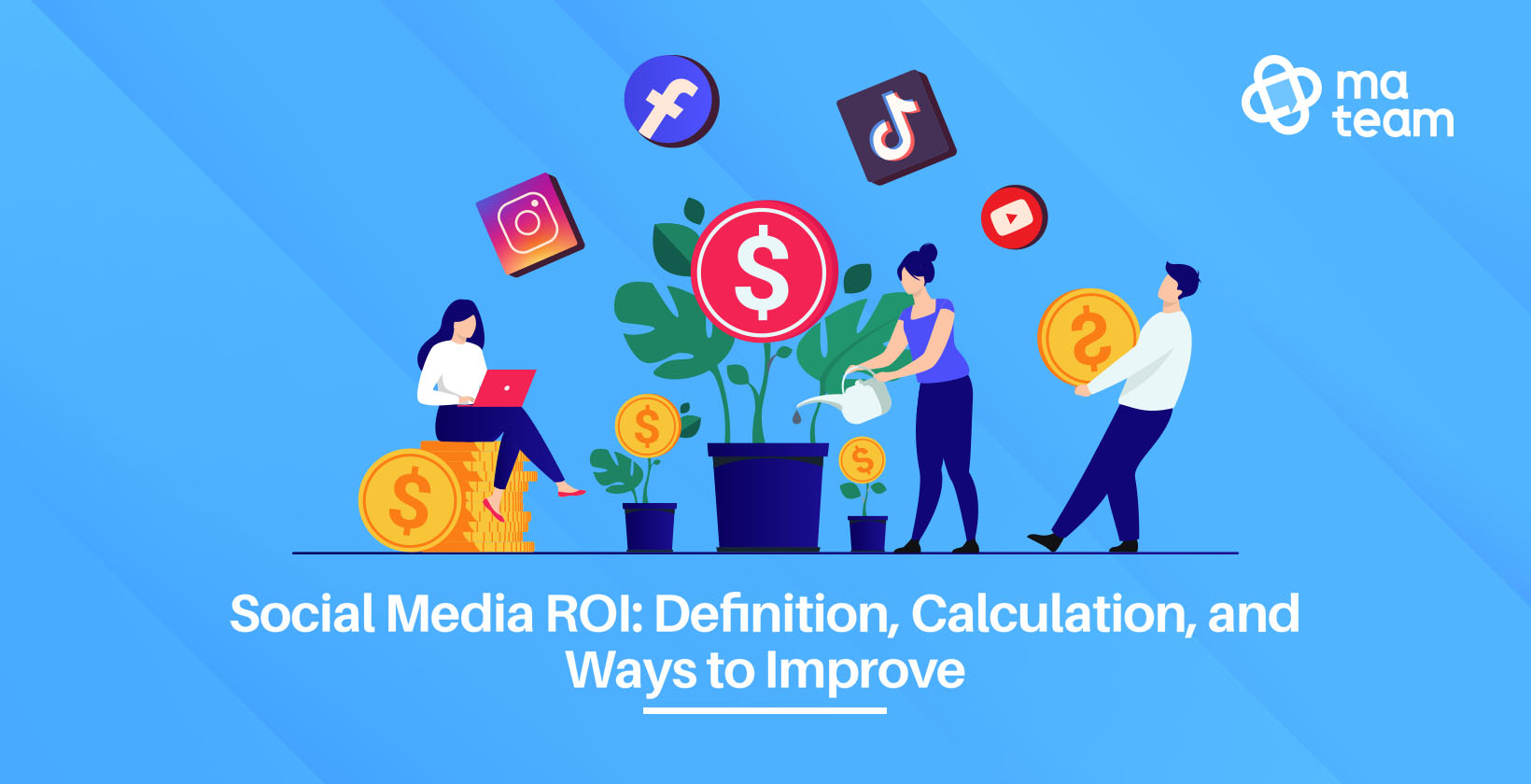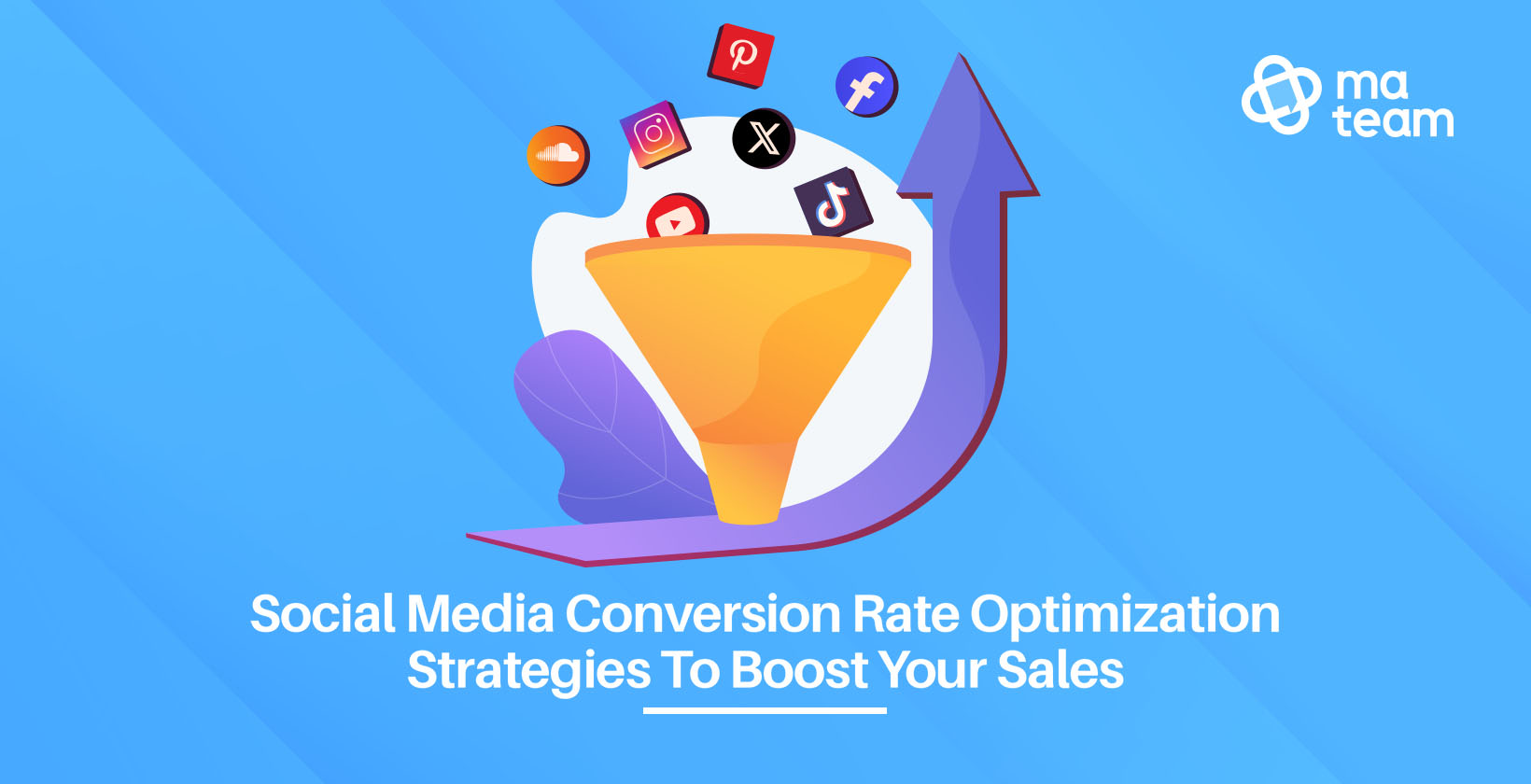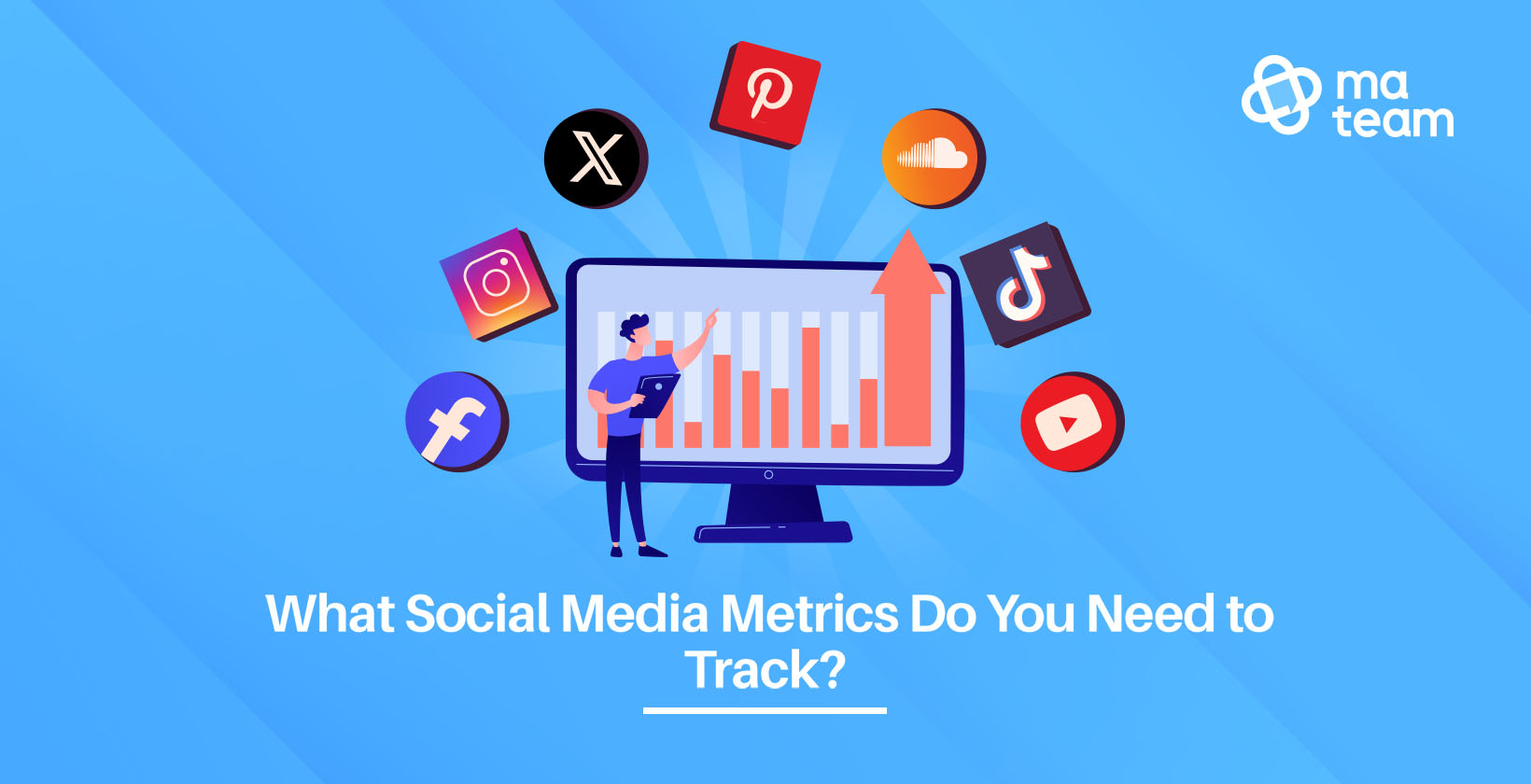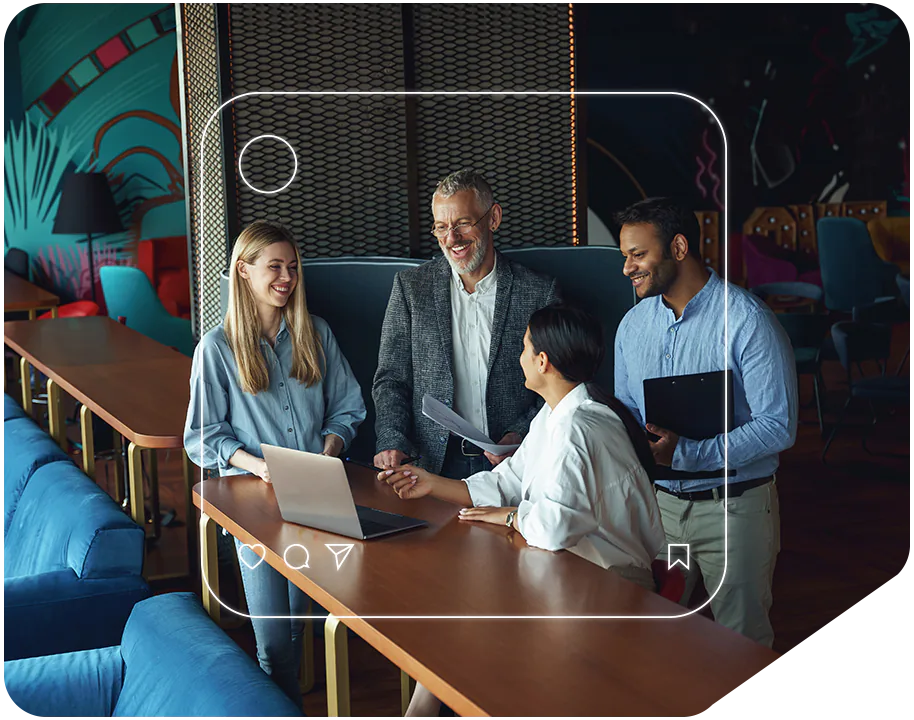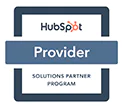Social media is a fantastic way to show the world who you are. What better place to share your interests, promote your business, connect with others, and talk about everything that you love and hold dear?
Social media varies widely, but it’s commonly classified into six categories: social networking, bookmarking, social news, media sharing, microblogging, and online forums.
Social networking lets you join communities and engage in real time. Bookmarking lets you save and organize online content, and social news allows you to discuss and vote on various trending topics.
Media sharing lets you upload photos and videos, microblogging is best for fast communication and quick updates, and online forums are a great place for asking questions and sharing your knowledge to help others on countless topics.
Then, you have social media platforms – places where you can share text posts, videos, and photos. Today, the most popular ones are Facebook, YouTube, Instagram, WhatsApp, TikTok, Telegram, Snapchat, X, and LinkedIn.
But how did we even get where we are today?
It all started back in 1997 with a platform called SixDegrees.com. We’ve come a long way since then, so today, we use social media not only for fun but to grow our businesses, too – through social media marketing, smartly placed ads, and much more.
People use social media to share beautiful moments, stay informed, and discover new things. It’s a place of endless possibilities, but it’s not without its risks.
Many encounter some form of misinformation online, cyberbullying, or privacy breaches. Scrolling can also take a toll on your mental well-being. If you spend too much time online, you could very easily forget about real life.
So, remember: What you see online is just a highlight reel, not the full story. It’s easy to get caught up in online perfection, but real life is beautifully imperfect.
What is Social Media?
Social media is a way to connect with others, share content, and communicate online. It includes apps and websites where you can post updates, send messages, and interact with people through text, photos, and videos. Popular platforms are Facebook, YouTube, Instagram, WhatsApp, TikTok, Telegram, Snapchat, X, and LinkedIn.
Each platform has its own purpose. Facebook is great for keeping up with friends, joining groups, and sharing life updates. YouTube is for watching and sharing videos, and Instagram focuses on both pictures and videos, making it perfect for creative content.
WhatsApp is a messaging app for texts, calls, and video chats, while TikTok is all about short, fun videos with music and trends. Telegram offers secure messaging, group chats, and news updates.
X is best for quick news, opinions, and discussions. LinkedIn helps you build professional connections and find jobs, and Snapchat lets you send disappearing messages and use fun filters.
Social media helps you stay connected, entertained, and informed. You can use it to learn new things, follow your favorite celebrities, or promote your business. Many companies and influencers use social media to reach specific audiences and share their ideas, values, hobbies, and passions.
But remember – social media is powerful, so use it wisely. Protect your privacy, think before you post, and don’t believe everything you see online.
What Types of Social Media Exist?
The types of social media that exist are listed below.
- Social networking
- Bookmarking
- Social news
- Media sharing
- Microblogging
- Online forums
Social Networking
Social networking is a type of social media where people connect, share, and interact online. It allows users to build relationships, join communities, and communicate in real-time.
Popular platforms of this type include Facebook, YouTube, WhatsApp, Instagram, LinkedIn, and X, each serving different purposes.
Facebook and WhatsApp help with personal communication, while Instagram and YouTube allow users to share photos and videos. X is great for quick updates, and LinkedIn focuses on professional networking.
Businesses also greatly benefit from social networking. Facebook and Instagram help brands connect with customers through posts, ads, and direct messages. YouTube is perfect for video marketing and tutorials, WhatsApp allows companies to provide customer support, and LinkedIn helps businesses with hiring and networking.
A strong social presence improves a company’s reputation. Customers trust brands that engage online. Companies can answer questions, share updates, and promote products. By tracking likes, comments, and shares, businesses can easily learn what people want and love the most.
Bookmarking
Bookmarking is a type of social media that helps you save, organize, and share online content. Instead of searching for a piece of content again, you can save it in one place for easy access.
Popular bookmarking platforms are Pinterest, Reddit, and Flipboard, which allow users to collect and share useful links.
People use bookmarking sites to store interesting articles, videos, and images. Pinterest is great for saving creative ideas like recipes, home décor, and fashion inspiration. Reddit lets users discover and discuss trending topics. Flipboard curates news and blogs based on personal interests.
Businesses can use Pinterest to show products visually and drive traffic to their websites. Reddit allows them to engage with niche communities and answer industry-related questions. Flipboard is useful for sharing blog posts and news articles to reach a wider audience.
A strong presence on bookmarking sites can increase brand visibility. When people save and share content, it spreads to more users. Businesses can also study trends by seeing what people bookmark the most.
Social News
Social news is a type of online platform where users share, discuss, and vote on news articles, blog posts, and trending topics. The most popular or highly rated content rises to the top.
Popular social news sites include Reddit, Digg, and Hacker News. Each has its own style. Reddit covers everything from memes to serious debates, while Hacker News focuses on tech and startups.
People use social news sites to stay informed, discuss trending topics, and discover new ideas. Unlike traditional news, users control what gets attention. This makes it a great way to see different opinions and find unique content.
Businesses can use social news sites for marketing, customer engagement, and industry insights. A well-placed post can drive massive traffic to a website.
Brands that join discussions and share useful content can build trust and attract customers. However, it’s worth noting that hard selling doesn’t work – users prefer natural, valuable contributions.
Media Sharing
Media sharing is the act of uploading, sharing, and viewing visual content like photos, videos, and graphics on digital platforms. These platforms focus on visual storytelling and allow users to engage with content through likes, comments, and shares.
Some of the most popular media-sharing platforms are YouTube, Instagram, TikTok, and Pinterest. YouTube is mainly for videos, while Instagram and TikTok focus more on short-form content. Pinterest is great for finding and saving visual inspiration.
People use media-sharing sites to express themselves, stay entertained, and discover new creators. These platforms allow anyone to show their creativity. Whether it’s a funny video, a travel photo, or a cooking tutorial, users love seeing and sharing fresh content.
Businesses can use media-sharing platforms to promote products, build brand awareness, and engage with customers. High-quality images and videos attract attention quickly. Companies can share tutorials, behind-the-scenes content, and promotions to connect with their audience.
Microblogging
Microblogging is a form of social media where users share short posts, updates, or messages. These posts are usually brief and can include text, images, links, or videos. The focus is on fast communication, making it easy to share thoughts, news, or ideas in real time.
Popular microblogging platforms include X, Tumblr, and Instagram Threads. X is the most well-known, offering short, real-time updates. Tumblr combines text, images, and GIFs, while Instagram Threads are focused on close-knit conversations and sharing updates with close friends.
People use microblogging to share opinions, stay informed, and connect with others. It’s great for following trends and getting quick updates. Users can engage with others through replies, hashtags, and reposts.
Businesses use microblogging for customer engagement, brand awareness, and industry updates. Short messages make it easy to share news and offer promotions, and hashtags help posts reach a wider audience. Engaging with trending topics can also boost visibility.
Online Forums
Online forums are digital spaces where people start discussions, ask questions, and share knowledge on different topics. Users create posts, respond to others, and participate in ongoing conversations. Forums are usually organized into categories, making it easy to find discussions on specific interests.
Some of the most popular online forums include Reddit, Quora, and Stack Exchange. Reddit has thousands of communities for different topics, while Quora focuses on question-and-answer discussions. Stack Exchange is mainly used for technical and professional topics.
People use online forums to learn new things, get advice, and connect with like-minded individuals. Forums allow users to have in-depth discussions, unlike social media posts that disappear quickly. Many people visit forums for problem-solving, whether for tech issues, hobbies, or life advice.
Businesses use online forums to build trust, provide value, and understand customer needs. By answering questions and sharing expert advice, companies can establish themselves as industry leaders. Forums also help businesses see what their target audience is discussing. However, direct advertising is often discouraged – helpful engagement works best.
What is a Social Media Platform?
A social media platform is an online service that allows users to create profiles, connect with others, and share content. These platforms support various forms of communication, including text, images, videos, and links.
Social media platforms have evolved since the early days of the internet. Early examples like MySpace, Facebook, and Bebo attracted millions of users who integrated them into their daily routines. Over time, these platforms expanded their features, incorporating photo sharing, blogging, and mobile connectivity. Today, social media includes a wide range of services catering to different needs and communities.
While all social media platforms allow users to interact, they differ in their purpose. Some, like Facebook, focus on maintaining real-world connections. Others, like Reddit, are built around shared interests. LinkedIn is designed for professional networking, while Instagram and TikTok prioritize visual content.
The ability to create and share content makes social media a powerful tool. It connects people across the world, helps businesses reach customers, and allows individuals to express themselves. As technology advances, social media continues to evolve.
What Are the Most Popular Social Media Platforms?
The most popular social media platforms are Facebook, YouTube, Instagram, WhatsApp, TikTok, Telegram, Snapchat, X, and LinkedIn. Each one has different features and is used for different reasons, from entertainment to networking.
People use Facebook to stay connected with friends, join groups, and share updates, while businesses use it to build brand awareness and communicate with customers. Advertising here is very effective because Facebook targets users based on their interests. The risk is that you can spend too much time scrolling. It also collects a lot of personal data, so privacy settings are important.
YouTube is for watching and sharing videos on any topic. People use it for entertainment, education, and tutorials. Businesses create channels to share content and attract customers. You can run ads on YouTube, and they are highly effective if targeted well. However, it’s easy to spend hours watching random videos, which can be distracting.
Instagram is a visual platform for sharing photos and videos. People use it for creativity, trends, and growing their businesses. Ads here are very effective, especially for brands with strong visuals. The risk is social comparison, which can negatively affect self-esteem.
WhatsApp is mainly used for private messaging, calls, and group chats. Businesses use it for customer support and marketing through messages. While advertising is limited, companies can send promotional messages. The risk is overuse, as constant messaging can be distracting.
TikTok is popular for short, engaging videos. People use it for fun, trends, and viral challenges. Businesses can create creative content to connect with younger audiences. Ads on TikTok are effective if they match trending styles. Still, it can be highly addictive due to endless scrolling.
Telegram is used for private messaging and group discussions. People like it for its security and large group features, and businesses use it for customer communication and updates. Advertising is not common here, but brands can engage users directly. The risk is misinformation since channels are not always verified.
Snapchat is used to share daily moments with friends. Businesses can create branded filters and stories to engage users. Ads are effective for younger audiences. The risk is that messages disappear quickly, which can lead to oversharing.
X is used for quick updates, discussions, and news. People use it to share opinions and follow trends, and businesses engage with customers and handle support. Ads are effective, but they must be well-targeted. The risk is negativity, as debates can become overwhelming.
Lastly, people use LinkedIn to connect with employers and share industry insights. Businesses use it for hiring and branding. Ads are great for targeting professionals. However, spending too much time scrolling through career-related posts can be a potential risk.
How Many People Use Social Media?
As of October 2024, 5.22 billion people, or 63.8 percent of the global population, use social media, according to Statista.
Facebook was the first social network to surpass one billion registered accounts. Today, it has over 3 billion monthly active users, cementing its position as the largest social media platform.
Meta Platforms, Facebook’s parent company, also owns three other major platforms: WhatsApp, Facebook Messenger, and Instagram. Each of these platforms has more than one billion monthly active users, showing Meta’s dominant role in the digital world.
What Are the Main Differences Between Social Media and Traditional Media?
The main differences between social media and traditional media are speed, interactivity, accessibility, cost, and audience targeting.
Social media spreads information instantly, while traditional media takes time. You can engage with content online, but traditional media is one-way. Social media is available to everyone, often for free, while traditional media requires significant resources. Online platforms allow precise audience targeting, unlike newspapers or TV.
Social media works in real-time. You can share updates instantly, and people can respond right away. Traditional media, like newspapers or TV, follows a schedule. If you post something on social media, it can reach thousands in minutes. A newspaper must be printed and delivered before anyone reads it.
Another big difference is engagement. On social media, you can comment, like, or share. Traditional media doesn’t allow direct interaction. If you watch a TV ad, you can’t reply to it. But on social media, you can react and even message the brand.
Cost is another factor. Posting on social media is free or low-cost. Producing a TV ad or running a newspaper article is expensive. Social media also lets you target specific groups based on interests, while traditional media reaches a broad audience without precise control.
What Are Social Media Zones?
Social media zones are different areas where people and businesses interact online. These include social community, social publishing, social commerce, and social entertainment.
The social community zone is where people connect and interact. For example, Facebook and LinkedIn allow users to join groups, share content, and engage with brands. Many companies use this zone to build relationships with their audience. Reddit and Wikipedia are also in this zone.
The social publishing zone focuses on content creation. If you’ve shared a photo or video, you’ve participated in this zone. Businesses use it to publish blogs, articles, or videos that attract attention. YouTube and X fall into this zone.
The social commerce zone is where businesses sell products and services. This includes online stores like Etsy and eBay. Customer reviews and social media ads help brands attract and keep customers.
The social entertainment zone is for fun and engagement. Gaming, interactive experiences, and streaming services belong here. Platforms like Twitch and YouTube offer entertainment while keeping users engaged with ads and promotions.
How Does Social Media Work?
Social media works by connecting people, sharing content, and allowing interaction online. You can post updates, photos, or videos, and others can like, comment, or share. Businesses use social media to promote products, and algorithms help decide what content you see based on your interests.
When you use social media, you’re part of a huge network. Every time you like a post, follow someone, or leave a comment, the platform learns what you enjoy. That’s why you keep seeing posts related to your favorite topics.
Most platforms have different ways to connect. You can send messages, join groups, or even watch live videos. Some apps focus on short content, like TikTok or Instagram, while others, like Facebook and LinkedIn, are more about conversations and networking.
Social media is always changing. New trends, memes, and viral content pop up daily. If you want to grow an audience, you should post regularly and engage with others. Whether you’re there for fun, news, or business, social media makes it easy to stay connected and share what matters to you.
Is Social Media Considered Technology?
Yes, social media is considered technology. It’s a digital tool that relies on the internet, software, and algorithms to help people communicate, share content, and interact online.
Social media platforms are built using advanced technologies, including artificial intelligence, cloud computing, and data analytics. Features like live streaming, personalized recommendations, and automated moderation are all powered by technology.
Social media also evolves with technology. As new innovations emerge, platforms add features like virtual reality, AI-driven chatbots, and enhanced security measures. Without technology, social media wouldn’t exist in the way it does today.
What is the History Behind Social Media?
The history behind social media started with SixDegrees.com, which launched in 1997 as the first recognizable social network. It allowed users to create profiles, list friends, and connect online. While it was ahead of its time, it failed to grow and shut down in 2000.
In the early 2000s, new platforms appeared. Friendster, launched in 2002, was one of the first to gain popularity, but technical issues and restrictions caused users to leave. MySpace, launched in 2003, became a favorite for musicians and young users, allowing personal customization. However, Facebook, launched in 2004, soon replaced it by focusing on real-world connections and privacy.
Other platforms also shaped social media. LinkedIn (2003) focused on professional networking, while YouTube (2005) became the go-to platform for video sharing. Twitter, now called X, launched in 2006, offering short text updates. Instagram (2010) and Snapchat (2011) introduced new ways to share visual content.
Today, social media continues to evolve, shaping how people connect, businesses grow, and trends spread worldwide.
What Was the First Social Media?
The first social media was SixDegrees.com, launched in 1997. It allowed users to create profiles, add friends, and connect with others online. It was the first platform to combine these features, making it the first true social networking site.
As we’ve mentioned above, SixDegrees was ahead of its time. It introduced the idea of online social connections, but most people were not yet used to the internet. Unlike today’s social media, there wasn’t much to do after adding friends. People joined but didn’t stay active, which made it hard for the platform to succeed.
Even though SixDegrees failed, it greatly influenced future social media. Today, social media is a huge part of daily life, and it all started with a simple idea – connecting people online.
What is Social Media Marketing?
Social media marketing is the process of using social media platforms to promote a brand, product, or service. It involves creating and sharing content to attract attention, engage with audiences, and build relationships with customers.
This type of marketing allows you to reach a large audience quickly. Facebook, Instagram, TikTok, X, and LinkedIn all help businesses communicate directly with potential customers. You can post updates, share videos, and interact through comments and messages to stay connected.
However, without a solid social media strategy, social media marketing becomes a game of chance. Posting randomly may gain some attention, but without a clear plan, it’s difficult to engage the right audience or drive real business results.
Why is Social Media Marketing Strategy Important?
Social media marketing strategy is important because it helps you reach the right audience, stay consistent, and achieve your business goals. Without a plan, your posts may not attract attention, and your efforts could go to waste.
A clear strategy helps you understand your audience. Knowing who you are targeting allows you to create posts that people actually want to see. This makes your content more relevant and increases engagement.
Another key reason is tracking what works and what doesn’t so you can improve your content over time. But managing all of this manually can be overwhelming, and that’s where social media tools come in to help you simplify the process.
How Can Social Media Tools Improve Your Marketing Efforts?
Social media tools can improve your marketing efforts by helping you schedule posts, track performance, and engage with your audience more efficiently. They save you time and ensure your content reaches the right people.
One major benefit of social media tools is scheduling posts in advance. Instead of posting manually every day, you can plan your content and let the tool post for you.
These tools also track performance and analytics. They show you which posts get the most likes, shares, and comments. This helps you understand what works best so you can improve your future content.
Another advantage is managing interactions. Social media tools allow you to respond to comments and messages in one place, making it easier to engage with your audience.
What is Influencer Marketing?
Influencer marketing is a type of social media marketing where businesses partner with influencers to promote products or services.
Influencers have large followings and can influence their audience’s buying decisions. Therefore, companies use influencer marketing to reach more people and build trust with potential customers.
This marketing works because people trust influencers. When an influencer recommends something, their followers see it as a personal suggestion rather than a traditional ad. This makes influencer marketing more relatable and engaging.
Brands choose influencers based on their industry, audience size, and engagement – everyone’s best fit is different.
How Can a Marketing Agency Help You Grow Your Social Media?
A marketing agency can help you grow your social media by creating a strategy, managing your content, and increasing engagement. They handle everything from planning posts to running ads, making it easier for your brand to reach the right audience and gain followers.
One big advantage of working with a social media agency is professional content creation. They design high-quality posts, write engaging captions, and ensure your brand looks consistent. This helps attract more people to your page.
Agencies also analyze your social media performance. They track which posts work best and adjust strategies to improve results. This means you don’t have to guess what will get more likes or shares.
Another benefit is social media advertising. Agencies know how to run targeted ads that bring in real followers and customers. This makes your marketing efforts more effective and cost-efficient.
Why Do People Use Social Media?
People use social media to connect with friends, share life moments, stay informed, discover new hobbies, find support, and entertain themselves. It’s where you can chat, laugh at memes, learn about the world, and feel part of something bigger.
Social media gives people a space to maintain relationships, even when they’re far apart. It’s a digital hangout where they can celebrate wins, share struggles, and bond over everyday life. It’s also a place to learn, whether through news updates, tutorials, or others sharing their expertise.
For many, social media is an escape – a way to relax by scrolling through funny videos or catching up on shows and interests. It’s also a place to explore passions. You might join a group about books, fitness, or gardening and instantly feel connected to others who love the same things.
Sometimes, people turn to social media for support. Whether it’s a tough day or a big challenge, communities online can make you feel less alone. They remind you that others are out there who understand.
Why Do Businesses Use Social Media?
Businesses use social media to build their brand, reach new customers, engage with their audience, show products or services, share updates, and gather feedback.
Social media helps businesses create a strong identity. They use it to show the world what they stand for.
Reaching new people is another big reason. Social media allows businesses to connect with millions, targeting specific groups based on interests, location, or habits.
Engagement is key, too. By replying to comments and messages, businesses build trust and relationships.
Social media also lets businesses share updates in real time, whether it’s a new product, a sale, or an event. Plus, by showing what they sell through posts, videos, and stories, they can attract interest and drive sales.
What Are the Types of Social Media Users?
The types of social media users are the Listener, the Activist, the Spammer, the Passionista, the Social Butterfly, the Troll, the Influencer, the Black Booker, the Early Adopter, and the Family Person.
Listeners quietly observe, rarely liking or commenting. Activists share causes they’re passionate about, using social media for change.
Spammers post irrelevant content that’s often ignored. Passionistas explore and share their interests with energy and positivity. Social Butterflies love showcasing their connections, often tagging others in their posts.
Trolls are known for being negative or argumentative, while Influencers create original, high-quality content to educate and inspire. Black Bookers use social media to build and maintain relationships, valuing it as a networking tool.
Early Adopters are the trendsetters who join platforms or try trends before anyone else. Finally, Family Persons use social media mainly to stay connected with loved ones across distances.
What Are the Risks of Social Media?
The risks of social media are cyberbullying, privacy breaches, misinformation, addiction, mental health challenges, and identity theft. While social media connects you to the world, it also brings all of these challenges.
Cyberbullying happens when people use social platforms to harass or harm others. It can damage self-esteem and create emotional stress.
Privacy breaches are another big risk, as sharing too much personal information can make you vulnerable to scams or misuse of your data.
Misinformation spreads quickly online. It’s easy to believe false news or facts when they look convincing. This can lead to confusion or poor decision-making.
Social media addiction is another concern. Spending too much time online can harm your real-life relationships and productivity.
Mental health challenges like anxiety and low self-esteem often arise from comparing yourself to others. Social media can make you feel like you’re not enough, even when it’s not true.
Lastly, identity theft is a serious risk. Hackers may use your personal information to steal your identity or commit fraud, so you must be really careful. It’s advisable to use strong passwords, enable two-factor authentication, and keep a watchful eye on phishing scams.
Can You Get Addicted to Social Media?
Yes, you can get addicted to social media. It happens through constant scrolling, needing likes and validation, spending excessive time online, using it to escape real-life problems, feeling anxious without it, and prioritizing it over important tasks or relationships.
Social media addiction can start innocently, like scrolling through your feed to pass the time. Over time, it can turn into a habit where you feel the need to check your phone constantly. Likes and comments can become a source of validation, making you crave more approval from others.
Sometimes, people use social media to avoid dealing with real-life challenges. It becomes a way to escape stress or difficult emotions. The problem grows when you feel anxious or restless if you’re not checking your notifications.
Another way addiction shows up is when you prioritize social media over things that matter – like work, studies, or time with loved ones. You may tell yourself it’s just “five more minutes,” but hours can slip away.
It’s important to recognize these patterns early. Social media is a great tool when used wisely, but taking breaks and setting limits helps you stay in control. Remember, it’s okay to unplug and focus on your real life. You’re not missing out – you’re recharging.
How Social Media Affects Mental Health?
Social media affects mental health in terms of self-esteem, anxiety, loneliness, comparison, sleep disruption, and emotional well-being.
As we already mentioned, social media can create patterns of overuse. Constantly seeing others’ highlights can make you compare your life to theirs, even though what you see isn’t the full story.
Social media can also heighten feelings of anxiety. The pressure to keep up with trends or post perfect content can leave you stressed. For some, it leads to a fear of missing out (FOMO), where you feel like everyone else is having a better experience.
Loneliness is another impact. Ironically, while social media connects you, it can also make you feel isolated when online interactions replace real-life connections. Poor sleep is common, too, as late-night scrolling disrupts your rest.
The key to protecting your mental health is balance. Enjoy the connections and creativity social media offers, but don’t let it take over your life. Take breaks, set boundaries, and focus on what truly matters – your well-being and the meaningful moments offline. You’ve got this!
